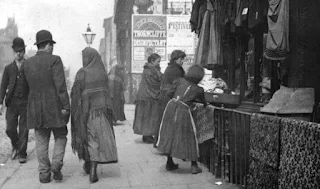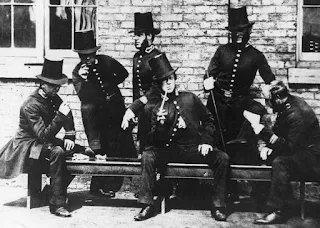OLD MANCHESTER & THE INDUSTRIAL REVOLUTION
An old lady newspaper seller
Old Manchester & the Industrial Revolution
Report by Don Hale.
Manchester, like so many other major cities throughout the country was completely transformed by the Industrial Revolution. It led to the rapid construction of canals, railways, housing, and scores of factories - many were built close to rivers and made extensive use of waterpower.
The city soon became a magnet for people seeking accommodation and work. And part of this labour force included many Irish immigrants, who started to arrive in great numbers from about 1852, followed by the Italians in1865, and numerous other foreign workers. The unprecedented growth of cotton mills and the increasing demand for additional labour continued to swell the population of Manchester.
In 1811, the regions census figures showed a population of 79,459; and by 1838 it had more than doubled to 181,708. It continued to increase, reaching 303,382 just thirteen years later in 1851; and by 1891, the population was estimated to be 563,368.
Manchester quickly became the centre to the cotton trade and merchants travelled with imported goods from Liverpool and other ports to make use of spinners for conversion of products in the factories and cotton mills. The sudden and controversial use of the rotary steam engine and other crucial mechanical devices - invented by pioneers Richard Arkwright and James Watt - again had a major impact on the region.
Mill owners naturally considered the children to be key workers. They were far more flexible and young girls or very small children were preferred as they were required to climb under or between machines to gather loose cotton. The children were also paid up to ten times less than adults.
They earned the nickname of “Scavengers” but some unfortunately endured rather short and uncomfortable lives, many suffering from broken bones and deformities. This was a dirty and dangerous occupation and resulted in numerous horrific injuries and many fatal accidents. By 1830 there were five hundred and sixty cotton mills recorded in the area, employing some 110,000 workers.
The dangers at work were not the only hazards. The main everyday killers at that time were tuberculosis, cholera and typhoid. In children however, diarrhoea was a major cause of death. Many of the health problems at the early part of the century were caused by a lack of hygiene and sanitary conditions. Clean drinking water was almost unheard of, and rivers were being used for both household water supplies and the disposal of raw, and untreated sewerage.
The situation was so bad in Manchester at one time, with cholera and typhoid particularly rife, that the authorities identified certain Manchester suburbs as “death zones” and included Ancoats, Ardwick and Chorlton on Medlock. Salford too had its own particular health concerns.
Communal cesspits were common and often overflowed into rivers and streams when swelled by the winter rains. Stockport was hit by a severe cholera epidemic in 1832 and this disease was a regular summer visitor to certain other Manchester suburbs.
There were numerous other epidemics and in factories there was also an illness commonly known as “mill fever,” which led to problems of nausea, dizziness, headaches and aching limbs. Working with cotton lint and dust was deemed to be the main cause of this problem but without any health or safety precautions in place, the disease and high fatality accident rate accelerated unchecked.
It was well into the 19th century before the problems of sewage disposal and the provision of fresh drinking water was successfully addressed. In 1850, the first supplies of fresh water from Longendale Reservoir began to arrive with extensive piping into the city. This supply however, was not available throughout the region, and many still had to queue for hours on end to obtain their small supply in buckets. And this still officially had to be boiled before drinking.
Two years later the Sanitary Association was formed, followed by special isolation hospitals set up to deal with the worst cases of disease. By 1890 additional clean drinking water was available and piped to Manchester from the Lake District. Despite certain advances in household services, most working class people still lived and died in despicable conditions of extreme poverty. Long hours, work dangers and the ever-present threat of illness and hunger severely reduced normal life expectancy.
Many parishes were only able to look after a limited number of poor or destitute families and the Victorians soon began dividing people into two main classes of “deserving” or “undeserving.”
Widows, orphans, the elderly and those too ill to work were classed as “deserving” and consequently were helped via the Parish in poor houses. Meanwhile, unemployed workers and criminals were called “undeserving” and were left to their own means for survival. Prosperity was available to the chosen few for many more decades and the poor continued to suffer at the hands of unscrupulous employers until various forms of legislation were gradually introduced.
THE COST OF LIVING.
The Victorian age was definitely nothing like the ‘good old days’ often portrayed on the silver screen, and was in fact one of distinct and conflicting contrasts, between people who had everything and others who had absolutely nothing!
Poverty, starvation and unemployment were commonplace together, with a host of the deadly diseases already mentioned. It was very much a horse-dominated world and the general public travelled to work by omnibus or trams, whilst aristocrats, wealthy businessmen and their families continued in the main to travel by private coach or carriage, and sometimes employed many coachmen. The coaches were usually decorated with the family coats of arms, or a notable insignia containing heraldic designs.
As an example of appreciating the cost of living and telling a little of life around 1890, I have also enclosed a selection of expenses and comparisons of wages in the public sector. And in a later section, I have reproduced some examples from ‘Self Education for the Police’ which highlights the role of the modern policeman in Victorian times and shows the amount of information he was expected to know prior to patrolling his city beat.
Policing and living costs at the turn of the century 1890-1900
In comparison, general labourers earned £46pa, a railwaymen about £43, and shop assistant £20. In the higher bracket, a bank manager could expect about £400pa, and music hall performer over £520pa. Rent and rates were high in comparison to wages and household accounts showed the regular purchase of lamp oil, washing soda, firewood sticks, candles, black lead, and scrubbing brushes.
A loaf of bread was 3d, a pint of milk one and a half pence, pound of cheese 5d, sugar a penny-farthing and a pound of potatoes, half a pence. Coffee was expensive at one shilling, and tea even worse at one shilling and five pence.
A newspaper, dependent upon whether a daily or evening, varied from a half-pence to a penny, and seats at the theatre ranged from six pence to four shillings! Admission to the zoo cost six pence and a ticket for the cinema one shilling.
Transport costs generally included, nine pence for a Hackney carriage ride per mile, and tram fares of three pence for a journey from the suburbs into town. Horse tram fares were cheaper but were soon phased out by the introduction of overhead electricity wires. Many people used a variety of community-based enterprise clubs for boots, clothing and essential supplies, and families somehow survived on a very mediocre diet.
















.jpg)
Comments
Post a Comment
Your comments are welcomed